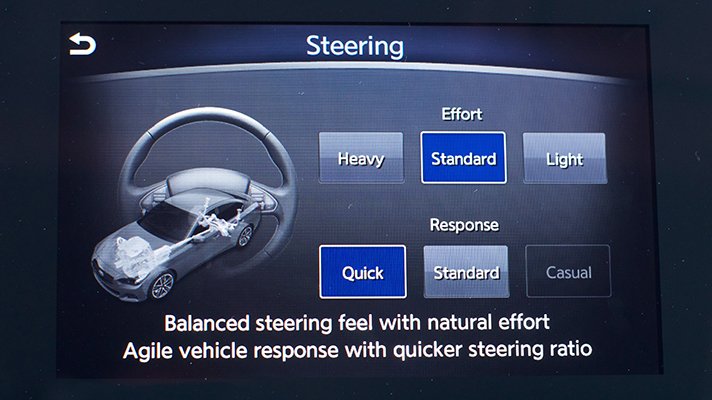
SPEC HIGHLIGHTS
- BHP
170bhp
- 0-62
8.7s
- CO2
119g/km
- Max Speed
143Mph
- Insurance
group34E
I suspect Infiniti has two target groups for the Q50. Either people who want an upmarket saloon but just wouldn't dream of hitching themselves to the BMW bandwagon. Or those who've had five 3-series company cars in a row and just, y'know, fancy a change. After all no manufacturer has much hope of going toe-to-toe with the 3-series because it defines the breed. But a good and diverting alternative stands a chance of gathering a keen minority following.
Infiniti has been here before with its G series. But the G only came with a thirsty V6 petrol or an expensive V6 diesel. Company-car buyers (which is nearly all buyers) demand a low-CO2 four-cylinder diesel or nothing.
Well the Q50 benefits from Infiniti's snuggle-down with Mercedes, and gets a version of the Benz 2.1-litre diesel, the one that's available in several power outputs across practically every car range Mercedes makes. Infiniti pegs it at a healthy 170bhp, but - out of insecurity? - calls it a 2.2-litre. It's 2143cc if you must know.
OK, diesel at the ready, Infiniti can now join the league. Can it win any games? Well because it's supposed to be alternative, it's got a pretty distinctive body shell, all wavy curves and sand-dune crested bone lines.
Indoors, it majors on tech, with two big custom dash screens. This has the advantage that you can keep the map always visible on the top one (if you've stumped £2k for navi anyway) while keeping the bottom one busy with the entertainment and an astounding range of connected apps.
The lower screen has excellent, clean sharp graphics, a good swipe-n-touch interface and low latency. The top one has a completely different look, different graphics style and colours and typefaces. One screen is flat, the other recessed. This mismatch is a face-slapping fail in an otherwise cohesively designed and nicely made cabin.
Another startling piece of differentiation is the steering. There's an option for the world's first entirely by-wire system, which goes by the name Direct Active Steering, or DAS for sort (there is a column, but it's always clutched out unless one of the three steering processors disagrees with the other two, in which case the system failsafes and introduces the column).
The steering setup measures your wheel movement, and decides how much wheel lock to apply depending on speed. Actually, it has three different speed maps from which you can choose. And various weights too.
Advantages? Because the ratio varies with speed, at low speed in town and around hairpins and mini roundabouts, you don't need to flail your arms. But at high speed it isn't twitchy. Also, there's no tramlining or kickback over one-sided bumps (which the 3-series suffers from) because there's no mechanical link. Because there's no need to isolate kickback, there was no need to mount the rack on rubber bushes, so actually the steering is more precise in its initial take-up.
But of course, it can't deliver 'true' road feel. Various sensors can work out when the grip limit is approaching, and at that point it reduced the weight you feel through the steering wheel. It works, up to a point. In fact it's better than most normal column-driven EPAS systems (and Porsche has a similar feedback logic in its EPAS).
Top Gear
Newsletter
Thank you for subscribing to our newsletter. Look out for your regular round-up of news, reviews and offers in your inbox.
Get all the latest news, reviews and exclusives, direct to your inbox.
But to be honest it's not needed in the diesel. The standard steering feels fine - maybe better actually - and since the car is prone to slightly soggy understeer, you're not really going to be driving it like that.
There's a much more fleet-footed 'sport' chassis fitted to the V6 petrol-hybrid version of the Q50, and that gets the DAS as standard. That car certainly corners more entertainingly, but of course it's hard to tell if the extra precision and feedback are coming from the sport chassis or the DAS.
Another reason you won't be caning the Q50 2.2d is the engine itself. It's pretty harsh-sounding (as it is in the Benz C-class), and its output tails off after about 3500rpm.
There's more. The seven-speed autobox is smooth when you mooch around in auto mode, but it's screamingly awkward when you want to get involved and over-ride it. There are no paddles, the gearlever plus/minus gate is back to front, and it always introduces a half-second delay between your command and its action. I didn't drive the manual but it would be going some to be worse than this. And the manual has a pretty decent 114g/km CO2 rating.
Oh, and the brakes are over-servoed and grabby in their initial bite, with a woeful lack of pedal feel. I'm really struggling to see how Infiniti's "Director of Performance" Sebastian Vettel has had much effect on the 2.2d. Again, the V6 has a better system, so maybe he's a busy guy and that's the only one he had time for.
But let's not get this out of proportion. The BMW 320d is everywhere but when did you last see one opposite-locking its way out of a roundabout? That's not how most people use cars like this. The Infiniti looks distinctive, it's reasonably competitive on tax and economy, it's well-equipped, it rides very well and most of all it's something different. Mission very probably accomplished.
Featured

Trending this week
- Car Review
BMW 1 Series




